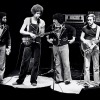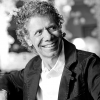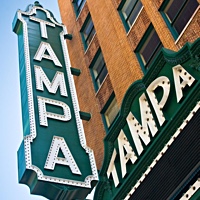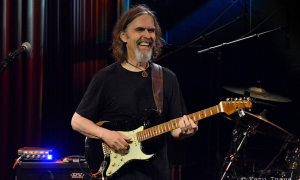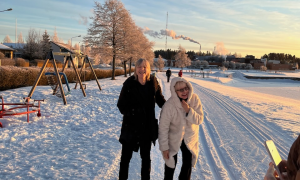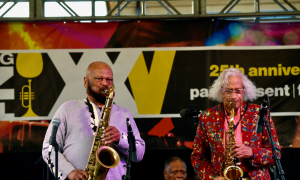Home » Jazz Articles » SoCal Jazz » Chick Corea: In The Present Tense
Chick Corea: In The Present Tense
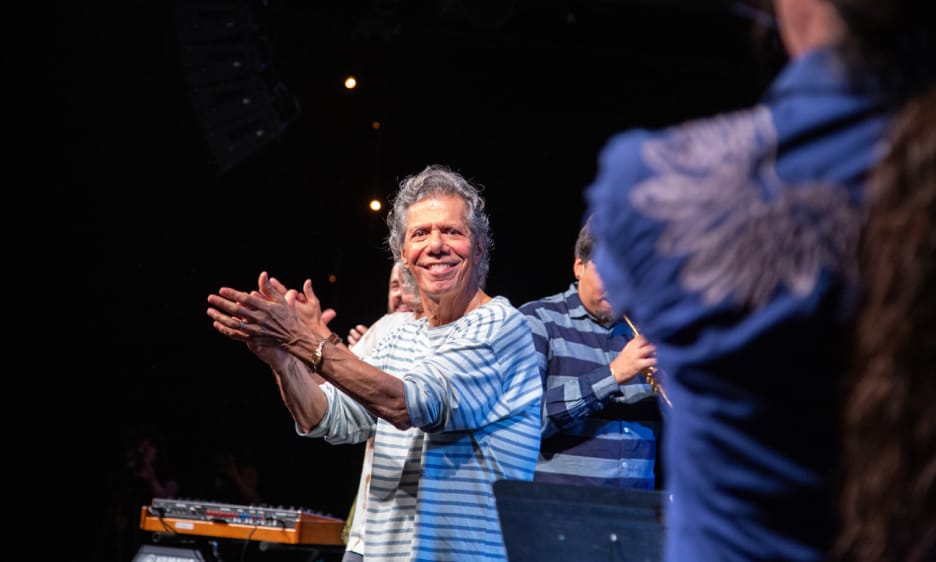
Courtesy Gerry Nanston
Right at eye level, there was a hole in the curtain at the Apollo Theater. Monk was right there, maybe two feet away. I got to see him play two shows a night for three weeks. That was Thelonious Monk University for me.
—Chick Corea
What can you say about music icon Chick Corea that hasn't already been said? His past, his career has been honored, dissected, and revered. As it should be. A composer and pianist of unparalleled skills and accomplishments, Corea's place in music history continues to plateau. In conversation with Corea, we centered mostly on what hasn't been said. We talked extensively about his new record and his new academy. Oh, we managed to go as far back as the fifties as he expanded on his background in correlation to the present. As engaging as ever, Corea continues to move forward. Now he has insightfully brought our musical history into the light of the twenty-first century.
All About Jazz: It's not every day that I have the opportunity to speak with a jazz legend. Chick Corea fits that description with an astonishing twenty-five Grammys to his credit. So, Chick thank you for taking the time to talk with AAJ today.
Chick Corea: Sure man, nice to talk with you. Let's talk about whatever you're interested in, Jim.
AAJ: Well, I'd love to talk about your latest record, which of course is actually a two record live set entitled Plays(Concord Jazz, 2020). One of the many things that jumped out to me is the mood you set with the audience. I've always thought that aspect is important to be in the right frame of mind to listen and really appreciate the music you are about to hear. It's truly extraordinary the way you invite the audience into your living room. Could you talk a little bit about the importance of creating atmosphere and how you go about it?
CC: That's a very basic and yet deep subject. We delve into what we consider to be the purpose of music. For me, I find the most enjoyment when I am able to get whatever ideas I have or whatever I am creating, when I am able to successfully get that across to a listener and I can help them feel what I am putting out and they can enjoy it. That's the ultimate success for me. I have found that with music that is not familiar to the ear, when I am playing new music or improvising, I don't even know what is coming out from moment to moment. I have found that in order for that kind of musical adventure to be communicated and received comfortably its necessary to be in a very relaxed environment. That's why I started talking to the audience more and say hello to them. I try to tell them just a little about what is on my mind and it seems to relax the situation. It helps them to follow and get a better grasp of my ideas.
AAJ: The way you do the vocal warmups and tune-ups' with the audience makes them laugh and loosen up and seems to plant the idea, as you are referring to, of accepting new melodies in their head. Now that they are in your living room it seems as though you are able to relax in that more intimate setting. Is that how it feels to you?
CC: Yes, the only way I can feel comfortable playing in any situation, whether its large outdoor audience or in a concert hall or a club or a small room or on television or whatever is It has to be relaxed and informal, just like you and me talking right now. Not like an artist up on stage with the lights on him and its dark in the audience and they become kind of a blur with no personalities. That is unnatural for me. It's not something I feel comfortable with. I've never done music that way. I like to make it informal.
AAJ: The record itself remarkably fuses or connects the dots of compositional genus from Wolfgang Amadeus Mozart to George Gershwin to Bill Evans to Antonio Carlos Jobim to Thelonious Monk to Stevie Wonder. I'm guessing you didn't need a search party to link those commonalities. More likely the Mozart sonata and Gershwin's "Someone to Watch Over Me" fit more like a glove in your mind. Is that somewhat accurate?
CC: Well, the whole idea is for me to present to the audience what my vision is. So, I'm not trying to make some sort of factual truth out of something. It's how my imagination works and I'm opening up that perspective to the audience. The Mozart is the second movement of a three-piece sonata. It's a slow lyrical movement. That piece was introduced to me by my longtime friend, who has now left us, Friedrich Gulda from Austria. He used to play it and he really loved that melody. I remembered the piece and its melodic value. I think of that melodic content and then think of another piece that has the same sort of tonality. It's a connection in my mind to go into "Someone to Watch Over Me" adjoining it with the Mozart piece. In announcing that to the audience I want them to think of Mozart and Gershwin as being here now. Their music is here now. I'm playing it now. Here we all are in the same room.
AAJ: Yes, I really appreciate the way you bring their music into a modern context. It's remarkable. Introducing a common thread from Mozart to Gershwin is fascinating. I never would have thought of Bill Evan's "Waltz for Debby" at the same time as Jobim's "Desafinado." But it might be the boldest illustration of the overall historical commonalties you are presenting. Just trying to get into the mindset, what are the elements that pair those two compositions?
CC: Well, it's nothing very erudite or deep. These associations in my mind can change from hour to hour or day to day.
AAJ: Interesting.
CC: Yeah, it's not that Mozart is now affixed to Gershwin. That's not the idea. The idea is that as I play or interpret one thing in my mind it flows naturally into this other thing. So, whatever those two things are become associated in my mind. If I can announce that to the audience before I do it then they can get some kind of handle on it. Sometimes I will put Jobim together with Chopin rather than Bill Evans. This is because I think that Jobim's music, and that of many other Brazilian composers, is very much influenced by the melodies of Chopin. In other words, whatever associations are in my mind are what I am sharing with the audience. Talking to the audience about it not only gives them a grasp but also allows them to be involved in the process.
AAJ: Absolutely, you are painting a picture with your music, as well as with your shared thoughts. You close the first set with a scintillating homage to Thelonious Monk. Your telepathic connection with Monk goes beyond that of all the many other composers. It's really uncanny. When did you first feel that dialed into Monk?
CC: Way back when Monk was sort of one of my teachers. Just from seeing him play and listening to his music. I was dialed in through my dad's record collection with the 78rpm records of Diz and Bird, the Billy Eckstine Big Band with Art Blakey as a young drummer and Sarah Vaughn as a young vocalist. In fact, Charlie Parker and Dizzy Gillespie were in Eckstine's band. Those were some of my early beginnings and Monk was always there with his music. Monk was senior to Diz and Charlie. He was a little older than them. They learned a lot from Monk. He had tremendous influence on them and many other musicians. Monk is considered by many to be the father of bebop.
AAJ: I can understand that. Monk was ahead of his time, so it makes sense that he was leading the way.
CC: Yeah, and I was fortunate enough to see Monk's band play live many times in New York. There was a two to three-week engagement at the Apollo Theater. I was playing piano with Mongo Santamaria and we opened the show. There were three bands playing on these shows. The second band was Monk's quartet with Frankie Dunlop on drums, John Ore on the bass, and Charlie Rouse on saxophone. I used to stand backstage behind a curtain. Right at eye level there was a hole in the curtain. It was an old curtain. It was perfect. Monk was right there. Literally if I had put my arm through the curtain, I could have touched him. He was maybe two feet away from me. I got to see him play two shows a night for three weeks.
AAJ: That had to be amazing. What an opportunity.
CC: Yes, that was Thelonious Monk University for me. He was a very inspiring musician for me.
AAJ: I think someone put that hole there on purpose. It was just too perfect.
CC: They put it there for me, man.(laughing)
AAJ: So, if Monk played second, who played next?
CC: Oh, the third band, the closing act, was the Maynard Ferguson Big Band.
AAJ: Wow, quite a show.
CC: Yeah, it was great, man.
AAJ: Well, talking about live shows, I had the pleasure of seeing you play a couple of years ago at the Balboa Theater in San Diego. It was part of your Trilogy 2 (Universal, 2018) tour with Christian McBride and Brian Blade. First of all, I was enthralled with the show. Your trio's musicality was amazing from beginning to end. But I mention it here in relationship to our conversation about relating to the audience. The ease of your banter and your self-effacing soNATTa and ScarLATTi (in a Boston accent) really put the audience at ease.
CC: (laughing at the accent comment)
AAJ: It's very relatable and creates that kind of relaxed informal atmosphere you have spoken about.
CC: One way to look at it, if I were to try to explain it in a social way, is that if you take the age old golden rule of treating others as I would like to be treated. If I figure out how I would like to be treated if I was a member of the audience. I would like to be treated in a straight-ahead manner. This is how I approach it. I don't know if I did it the night you saw us, but I usually like to have the other members of the trio speak to the audience as well. It's not as if these guys are backup players.
AAJ: Not hardly. Those cats are great. It's an equal footing trio, as it should be.
CC: That's exactly right. So, when they talk to the audience it lets them know that this is a team up here and I want them to get to know these guys as well.
AAJ: Yes, McBride and Blade both warmly addressed the audience that night in San Diego. Getting back to Plays, you open the second set with a wonderful tribute to the memory of your longtime friend and musical colleague Paco de Lucia and go in to a new arrangement of "Yellow Nimbus" that stretched the boundaries in both a heartfelt and improvisational way. Could you share a few words about your friendship and musical connection with Paco?
CC: Well, I should first say that my introduction to music was bebop and jazz. I was listening to Diz and Bird, Miles Davis, Monk, and those kind of guys. These guys had a very cool demeanor. Diz was quite the entertainer, but mostly when these guys played, they were very serious about it. They weren't concerned about entertaining. The music of that era was quite demanding. You had to be into it to really grasp it. Whereas when I first heard Latin music, with that beat coming out of New York and Puerto Rico and Cuba, that gave me a whole other emotional outlook to music. Guys like Eddie Palmieri and Machito were playing uplifting happy music. It struck something in me. So, when I met Paco it sort of rounded out that education for me that I had started to get from the music of Ray Barretto, Tito Puente, and Palmieri. The flavor of the flamenco rhythm and the way the singers and dancers told stories. Paco was a very big inspiration to me, and we became very good friends. We appeared on one another's recordings and we had a lifelong friendship.
AAJ: So, you had just about the right taste and background with the Latin sound to really appreciate and benefit from being hands on with Paco. Like you said it made it made it kind of full circle.
CC: Yes, the actual tradition of flamenco music is another strain on the planet. It comes from the Middle East. The rhythms are similar, but they have a whole ethnicity to them that is different than the Afro-Cuban rhythms. It was a language that I didn't know very well. Working with Paco and his musicians I was able to get the feel of how that music is put together.
AAJ: Also on Plays you do on the spot musical portraits of audience members, similar to what you used to do with your family in your living room and then did a couple of duets with audience members. In this case they were pretty experiences players that were holding their own.
CC: That night in Paris was a very particular night. There happened to be two young guys in the audience that raised their hands. I had never met them before. I was pleasantly surprised at their abilities. We had a great time playing together. I found out later that they are both pros with their own bands and recordings. Usually when I ask someone to come up and do an improvised duet with me there is a lull, a hush in the audience. They are trying to figure out if I am even seriously asking that. Often the youngsters are the ones who aren't afraid to come up on stage. Five-year olds, ten-year olds, twelve-year olds, I get all different levels of players that I play with. I just try to interact at what ever level someone is at and give them a good experience. I wan them to feel good and end up feeling like they have accomplished something. That's my fulfillment.
AAJ: I think that is a very unique and special thing to do. It's entertaining for the audience, an amazing opportunity for a couple of people each night, and certainly expands that smaller, intimate, just hanging out in the living room environment.
CC: Yes, I have put in just two rules. I don't want it to go on all night, so I limited it to two people per show. I also try to have one man and one woman. One other thing is that sometimes people will point to the person with them and indicate that the person can play and try to get me to choose them. I won't do that. The rule is that the person has to raise their hand. They have to be the one that wants to come up and do it.
AAJ: You aren't looking to put anyone on the spot that isn't comfortable doing it.
CC: That's it exactly.
AAJ: In recent years you have stated on many occasions that the fun factor is high on your priority list. The programs that you put together would seem to be designed with that very much in mind.
CC: I challenge my self to prepare programs that challenge me, so that I can stay on that edge of improvisation. I don't want to just roll it out the same way I rolled it out last time. I want that fun of it's a new night and a new rendition. There is an edge to it in that way. The adventure of that edge is the fun. There are different ways to have fun. You can play volleyball or tell jokes. You can also have a musical adventure that you don't know everything that is going to happen. You might have a setlist, but you still don't know just how that is going to roll out. You don't know what your partners are going to throw at you on any given night. Not knowing creates the adventure and thus the fun.
AAJ: Shifting gears, you have the Chick Corea Academy that I would love to talk about and let more people know about it. It I believe is somewhat spawned from your book, A Work in Progress. What can you tell us about your academy?
CC: Well, the whole idea of the academy has really been going on for years. Ever since I started teaching master classes and speaking to youngsters. Even before that I would get fan mail with musicians asking questions about how you do this and that. I found that if I answered honestly and in an encouraging way that it would be helpful to them. In my mind when I am able to help another musician to pursue a life in music, this is something very positive. The more artists that we have in our communities the better. Artists that are active and creating are contributing to a calmer environment, a more pleasant environment. I found that I could contribute that way. That idea kept germinating in my mind. When the pandemic hit in March I had to come back from Europe. I was in Europe with McBride and Blade doing our Trilogy tour. We were lucky to get on a plane just in time before the lockdown. Once I got home a friend told me that I could go on Facebook and play live any time I wanted to. I didn't know that, but I thought I would try it. I got on there one day and I couldn't believe how many people responded. Conversations started about this and that and how do you do that, etc. I was particularly interested in questions from musicians wanting to improve themselves. I did thirty-five days straight of an hour or two on Facebook. Then I decided that I should formalize this just a little bit. I didn't want to make it into a school because I don't really believe in examinations. The academy concept works for me. We have discussions on various subjects in order to raise the quality and awareness through an exchange of ideas. The academy is growing. We have done many workshops, with many more to come. I invite guests and we basically answer questions.
AAJ: What's inspiring is that it is apparent in the manner in which you talk about it that you genuinely want to help other musicians and take pride in it.
CC: The overall thing is that I wan to help improve conditions. Improving a condition isn't a generality. Its starts at home with your family, your community, and the people that you are in contact with. I have notice that the more people that are involved in the arts, any kind of artform, there is a more peaceful saner feeling. I have also experience that in times of trouble, like now with the pandemic, there is a lot of worry going on. When the artistic impulse is happening, we can think more clearly. We aren't in a worry mode. We can talk about the pandemic and what we need to do in a more calm and rational way. A big part of the purpose of the academy is to help and inspire people to pursue art.
AAJ: So the academy could be of benefit to all ages and all levels of musicianship?
CC: There are no limitations. I answer questions and have conversations at all levels. You mentioned my book, A Work in Progress. It covers a wide area of subjects on being an artist. So basically, what I am doing with the academy is presenting myself as an open book. Welcome to the academy is welcome to my living room. Let's talk about your individual problems and needs. What can I help you with? We have pro musicians, we have young students, we have musicians that play as a hobby. I'm interested in having discussions and helping anyone that I can.
AAJ: You have various discussions at different levels and different subjects that are ongoing.
CC: Yes, yes, exactly. Our past workshops are all available to new subscribers. I want to share it. I want to help people. I also have some guests that are on some of the workshops. I recently had Eliane Elias, you are likely familiar with her.
AAJ: Of course, she's terrific. I had the pleasure of talking with her just last year.
CC: I've had Carlitos del Puerto, and my electric band partners, John Patitucci and Eric Marienthal. Dave Weckl will be coming on soon.
AAJ: Well, you've got piano, bass, drums, and saxophone covered right there. Those cats have to add a lot of depth and knowledge to the discussions. I must say I have really enjoyed our discussion this afternoon. I had the pleasure of reviewing Plays a couple of months ago, so it was fun talking about the record in depth with you. Thank you very much, Chick. A real treat to speak with you today.
CC: Sure thing. It was nice talking with you as well, Jim.
Tags
SoCal Jazz
Chick Corea
Jim Worsley
United States
Florida
Tampa
Wolfgang Mozart
George Gershwin
Bill Evans
Antonio Carlos Jobim
Thelonious Monk
Stevie Wonder
Friedrich Gulda
Billy Eckstine
Art Blakey
Charlie Parker
Dizzy Gillespie
Mongo Santamaria
John Ore
Charlie Rouse
Maynard Ferguson
Christian McBride
Brian Blade
Paco de Lucia
Miles Davis
Eddie Palmieri
Machito
Ray Barretto
Tito Puente
Eliane Elias
John Patitucci
Eric Marienthal
Dave Weckl
PREVIOUS / NEXT
Support All About Jazz
 All About Jazz has been a pillar of jazz since 1995, championing it as an art form and, more importantly, supporting the musicians who make it. Our enduring commitment has made "AAJ" one of the most culturally important websites of its kind, read by hundreds of thousands of fans, musicians and industry figures every month.
All About Jazz has been a pillar of jazz since 1995, championing it as an art form and, more importantly, supporting the musicians who make it. Our enduring commitment has made "AAJ" one of the most culturally important websites of its kind, read by hundreds of thousands of fans, musicians and industry figures every month.



